To tap the potential of "digital oil", how can zkTLS make personal data a priceable on-chain asset?

Reprinted from panewslab
04/01/2025·1MAlthough Web3 has built powerful tools and infrastructure, average Internet users still live in Web2.
Written by: Figo @IOSG
Preface
Cryptocurrencies have come a long way. The Layer 2 expansion solution has been launched, zkVMs have been released, and even ETFs have been approved. However, most people still feel like the blockchain realm is like a world isolated—those things that are just read in words that they have not actually used.
Why is this happening
The answer lies not in the technology itself, but in what it currently cannot reach: our digital life. Although Web3 has built powerful tools and infrastructure, average Internet users still live in Web2 — browsing, trading, and socializing on centralized platforms that control their data.
Until we can connect these two worlds in a way that requires no trust and privacy, mainstream adoption remains out of reach.
Why Web3 has not yet broken through
We often interact online – through banks, social media, streaming platforms, government portals. But all of this happens in a strictly controlled ecosystem. Our digital identities are scattered across platforms, each holding a part of our life: there are bank statements here, passport scans there, and work experience on LinkedIn.
This fragmentation brings two fundamental problems:
- Data Island: Your online identity is scattered on various platforms, each with its own rules and permissions.
- Missing ownership: You don't actually own your own data. At best, you have access – this access may be revoked, restricted, or arbitrarily monetized by others.
These problems are reflected in the friction we face every day. Want to prove your income? You may need to hand over your full bank statement. Need to verify your address? Be ready to upload your entire utility bill. These systems assume that full transparency is the only way to build trust, as there is no selective, verifiable disclosure infrastructure.
Web3 promises to give users control, but so far it has not fulfilled its promise in this regard—at least for everyday, Web2-derived data.
Missing part: Verified Web2 data
This is the real bottleneck: enabling Web3 applications to leverage the data we have generated – without compromising user privacy or introducing new trusted intermediaries.
There are two key challenges:
- Verification: How can we encrypt the data from Web2 sources be trusted without relying on a centralized oracle or API?
- Privacy: How do we just prove the necessary content – without exposing the complete data behind it?
Chainlink and other oracle providers have addressed some of the verifiability issues, especially for public data such as asset prices or weather conditions. But personal and user-specific data—such as financial records, qualifications, identity credentials—need to different methods. These data points exist after login and in encrypted channels, and their original design intention is not to be extracted or shared.
This is where zkTLS comes in.
What is zkTLS?
Most of the Internet runs on TLS (Transport Layer Security Protocol) – this is an encryption protocol that supports HTTPS. It protects about 95% of web traffic. When you visit a website, TLS ensures that your communication is encrypted and not tampered with.
zkTLS (zero-knowledge TLS) builds some new features on this basis: it allows users to extract and prove specific facts from Web2 data streams without revealing the full content or trusting third parties.
This unlocks two key abilities:
- On-chain verifiability: zkTLS can prove that the data comes from a specific Web2 source and has not been tampered with.
- Selective disclosure: It can prove a specific attribute—such as “my annual income is over $80,000”—without revealing the actual bank statement.
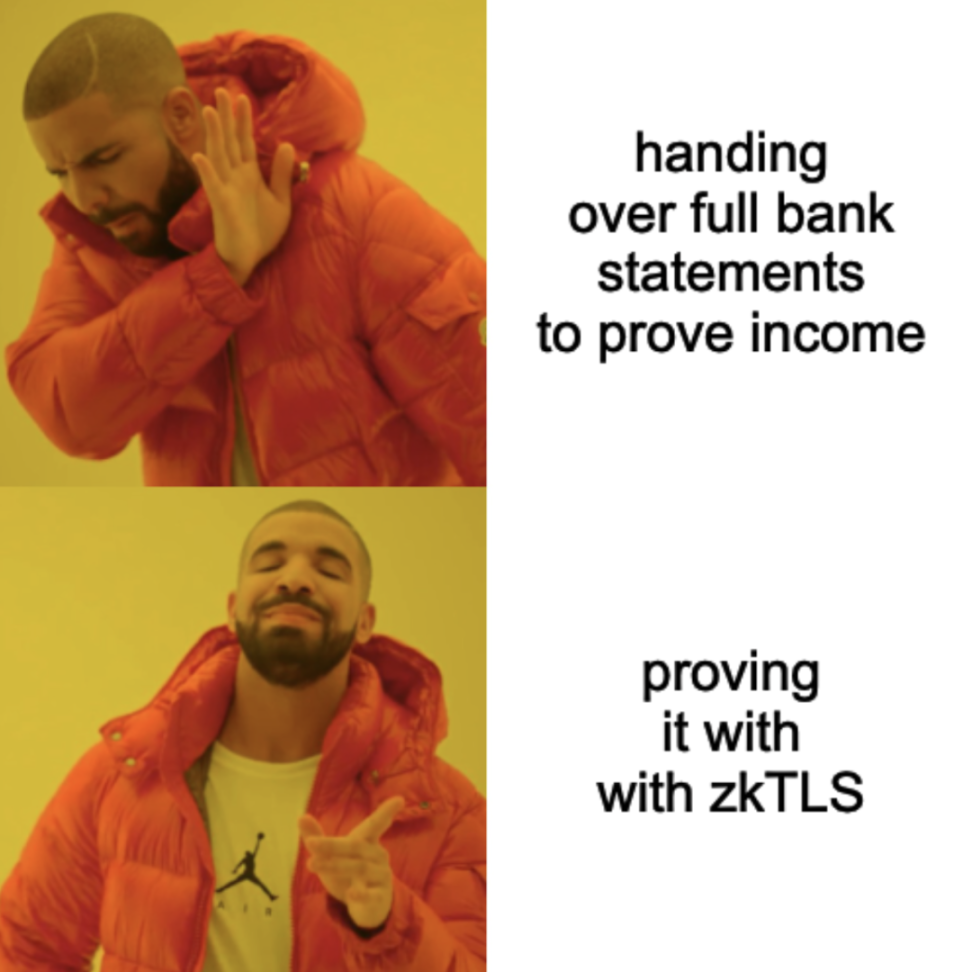
How does it work? Simply put:
- It captures encrypted TLS sessions between users and websites.
- It generates a zero-knowledge proof that a specific declaration (e.g., a value appears in the response).
- The proof can then be verified on-chain – without trust and private.
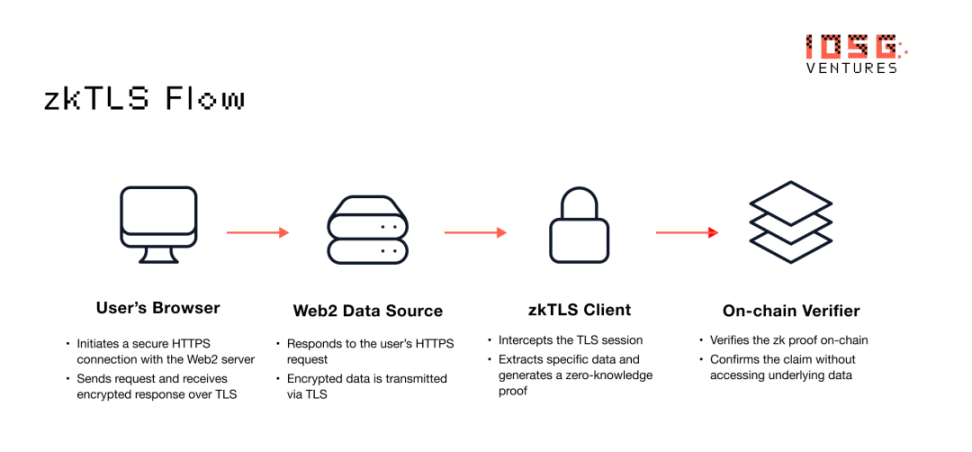
▲ Source: IOSG Ventures
This avoids the need to expose data to third parties or trust a centralized server to prove the data. Instead, trust is embedded in the cryptographic proof itself.
This is not just a theory. The implementation of zkTLS has been tested and deployed in consumer and DeFi use cases, indicating that verifiable Web2 data will become the default input for Web3 applications.
How zkTLS works
Not all zkTLS implementations are the same. Depending on the most important factors—speed, decentralization, or simplicity—different approaches perform well in different contexts. Here are three common architectures:
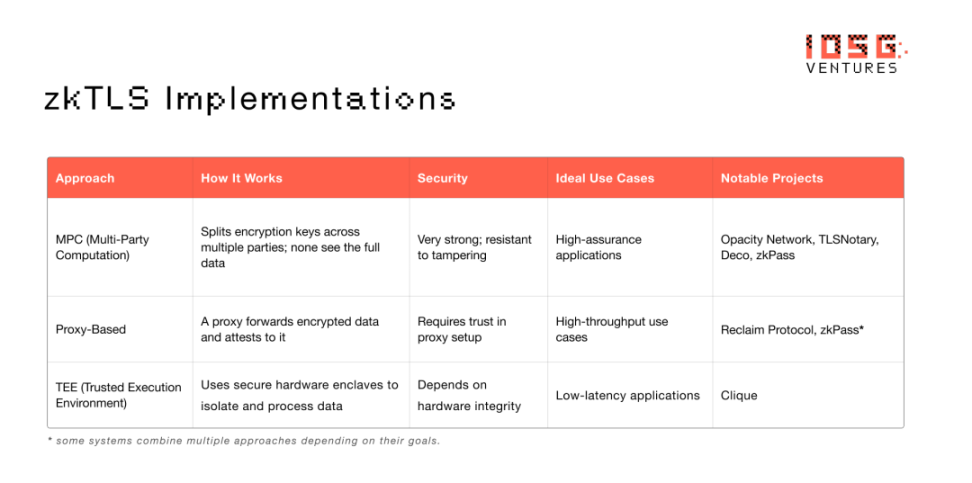
▲ Source: IOSG Ventures
Practical Application: zkTLS Where Changes Everything
zkTLS not only optimizes data processing—it also redefines the boundary between Web2 and Web3. By minimizing trust and private access to off-chain data, it allows applications to integrate real-world contexts without compromising privacy or decentralization.
Here are the ways it currently applies in different fields.
Financial Services
Due to the lack of trusted identity and on-chain financial data, most DeFi protocols still rely on over-solidation. zkTLS makes it possible to verify revenue, cash flow or account history – without exposing sensitive files.
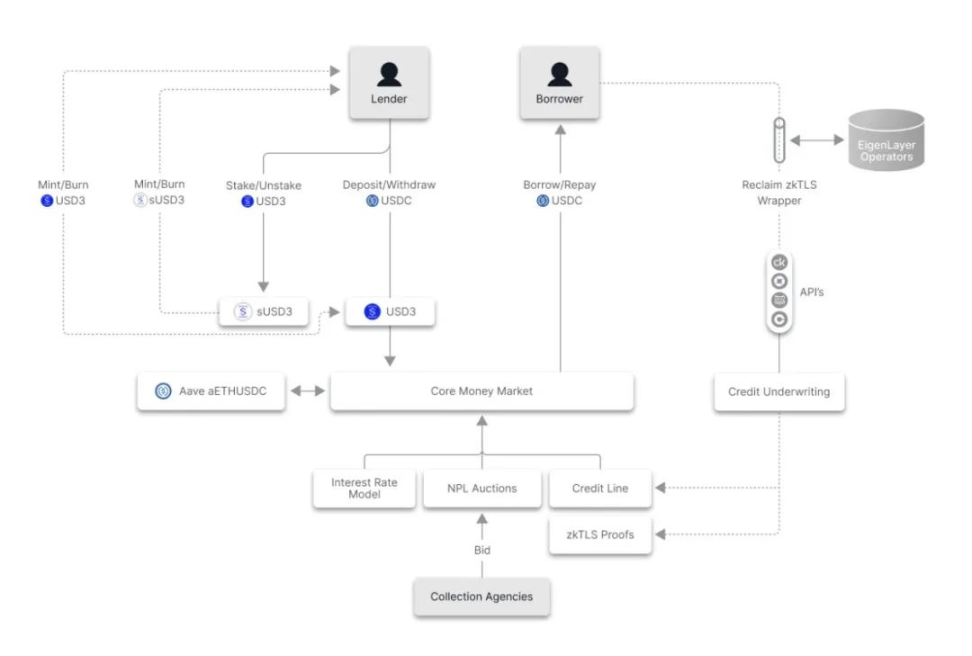
▲ Source: 3Jane
- 3Jane (3jane.xyz) is building a point-to-pool credit agreement that provides real-time, unsecured USDC credit lines for traders, farmers and businesses. Borrowers connect their wallets and Web2 financial data via Plaid to unlock credit based on verifiable proofs in DeFi, CEX and banks – no collateral required.
- Stormbit (stormbit.finance) supports a flexible peer-to-peer lending market where borrowers can privately prove income or account activity and unlock funds using zkTLS.
- The RWA (Real World Assets) tokenization project has begun to use zkTLS to verify land or property ownership through the government portal to achieve compliant on-chain assetization.
- zkP2P (zkp2p.xyz) is building a decentralized fiat to cryptocurrency portal, allowing users to use zkTLS to prove payments from Venmo, Wise or Revolut – no KYC, no intermediary, instant settlement.
These systems expand capital acquisition channels, bring credit value to the chain, and build a compliance bridge between TradFi and encryption.
Consumer Platform
In Web2, access to digital goods, subscriptions, and purchase history is locked behind a centralized API. zkTLS makes this data portable and proven—no permission required for the platform.
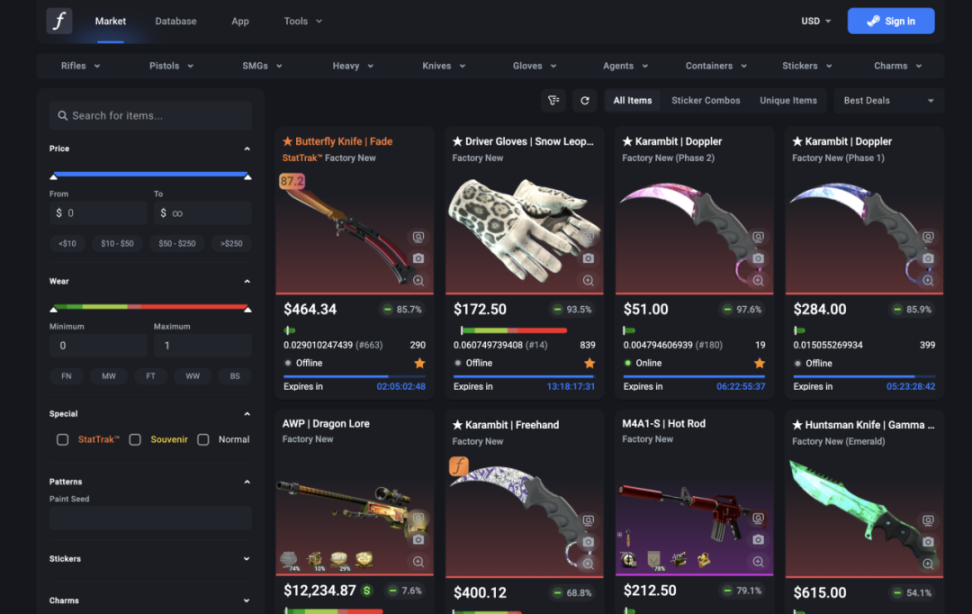
▲ Source: CSFloat
- CSFloat (csfloat.com) allows users to verify the ownership of Counter-Strike skins and collectibles through Steam data, enabling secure peer-to-peer transactions without the need for platform intervention.
- zkTLS is also used to demonstrate access to closed communities, subscriptions, or advanced content—no account links or API access required.
- In e-commerce, users can prove past purchase or loyalty program activities to unlock cashback, token rewards, or resale markets.
Now imagine proving that you have a Spotify subscription — or a luxury brand purchase — without exposing your full account. This is the power of zkTLS.
Identity and reputation
Today’s digital identity is fragmented and overexposed. Proving your identity usually means sharing everything. zkTLS changes this by allowing selective disclosure from trusted sources.
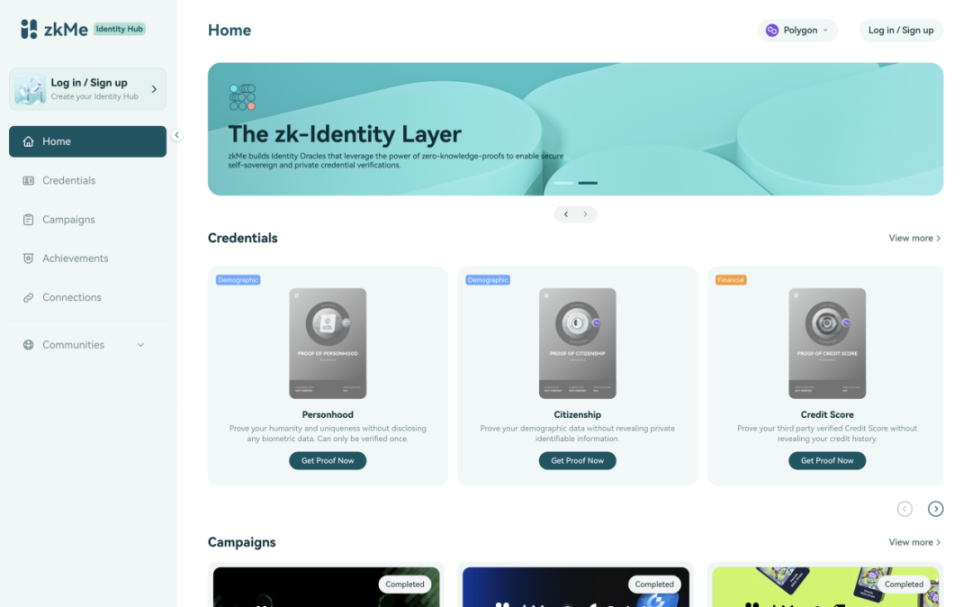
▲ Source: zkMe
- zkMe (zk.me) acts as a privacy-protected identity oracle that converts files and data from the Web2 platform into selective on-chain proofs.
- Zeru (zeru.finance) supports zScore, a cross-application reputation layer on Base. It validates credit scores, locations, or Uber history, etc. – no KYC required – so users can build verifiable profiles for use across applications and ecosystems.
- Icebreaker (icebreaker.xyz) allows professionals to create trusted, verifiable job profiles based on employment history and social graphs.
Now imagine someone building a Web3 version of Uber or DoorDash. The driver appeared with his zkTLS verification resume - no onboarding friction, no need to rebuild his reputation.
Social and content
We talk a lot about what we watch, play and interact – but the data is trapped in the platform. zkTLS unlocks this data, making participation portable and programmable.
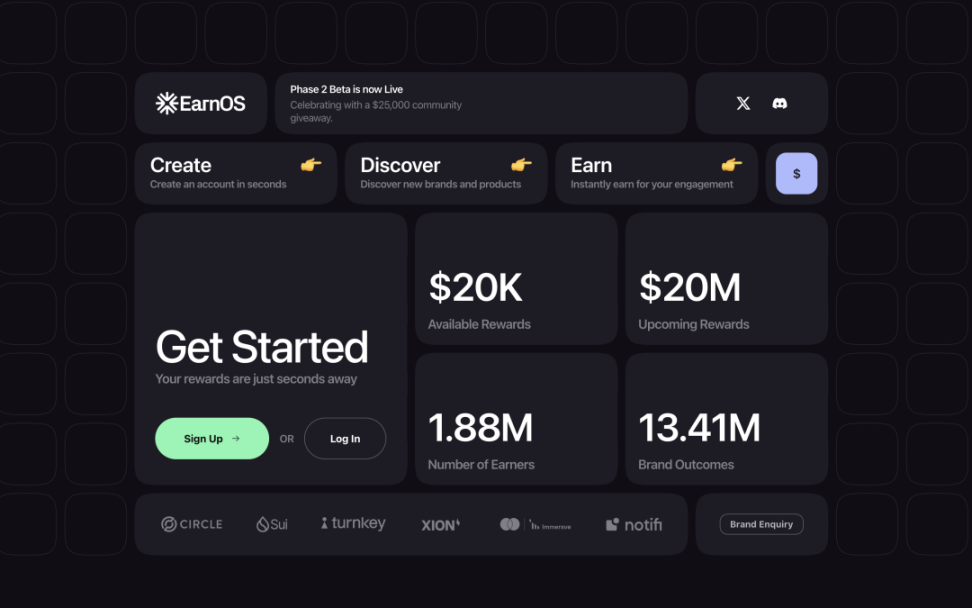
▲ Source: EarnOS
- EarnOS (earnos.com) lets users prove that they have seen or interacted with ads – without revealing who they are. Advertisers come into contact with real people, users receive rewards, and data remains private.
- Showdown (showdown.win) Verify game archives and performance data with FACEIT using zkTLS. Players can prove their skills and receive game-based rewards – no screenshots are required.
This unlocks the next wave of attention markets and participation-driven rewards – ultimately cross-platform portability.
Influence and behavior
Behavioral systems—whether they are fitness, sustainability, or rewards— require data that is often private and difficult to verify. zkTLS makes it possible to prove actions without surveillance.
- Daylight (https://linktr.ee/godaylight) Use IoT and registration data to verify ownership and usage of solar panels – without exposing the user’s identity or location.
- Fit Club (x.com/fitclubonbase) links sports rewards to validated Strava activities without revealing health or GPS data.
Other applications are exploring the use of zkTLS to demonstrate public transportation use, recycling, or participation in environmental projects—a incentive system that enables transparent, privacy-safety.
With zkTLS, we can finally prove real-world actions – without being monitored.
Emerging Frontiers
At the edge of AI, proxy and decentralized coordination, zkTLS provides the critical infrastructure for proof and trust.
- ElizaOS (elizaos.ai) is building autonomous agents to generate zk support logs for their actions – making AI decisions verifiable and auditable.
- Ketl (ketl.xyz) allows whistleblowers and experts to prove affiliation or insight without exposing their identities – bringing credibility to anonymous communications.
- zkTLS is also used to verify machine learning training data—to ensure authenticity while protecting contributor privacy.
As agents and AI become more autonomous, zkTLS anchors them to facts.
From certificate to ownership
zkTLS not only makes Web2 data available in Web3—it also makes it possessable. Credentials that were once isolated on the platform became portable, programmable, and privacy-protected.
As more applications adopt zkTLS, we will see a compounding effect: more verifiable data brings more powerful applications, giving users greater control — and more reasons to unlock data on their own terms.
This is not about replacing existing systems. Instead, give users control over them – and build a path for trust, privacy and composability to expand together.
The road ahead
If encryption wants to go mainstream, it needs to meet the needs of users—on the internet they already use. zkTLS provides the infrastructure to achieve this.
It implements:
- Encrypted trust in data from Web2 services
- No third-party privacy verification required
- User-controlled composable identity layer
- New applications based on verifiable real-world interactions
As more of our online lives become accessible through verifiable statements, a new generation of applications will emerge—those give users greater control, less friction, and unlock real value. zkTLS is more than just another protocol – it is a new way of thinking about how information moves between platforms and how trust is built on the internet.



 chaincatcher
chaincatcher